Isolation raising (or “iso-raising” for short) is a technique used by poker players to increase the number of hands they play against weak opposition.
It involves raising against a preflop limper in an attempt to create a heads-up pot.
Watch Kara Scott Interview with Martin Jacobson on Isolation Raise:
Table of Contents
Why Limpers are Weak
It’s a simple fact that most strong poker players do not open-limp (just call when first to act) on the preflop betting round. This fact is especially true in poker’s most popular variant, No Limit Holdem.
By raising when first to act preflop, players give themselves the best opportunity to win the blinds uncontested. Limping does not allow that to happen; a preflop limper must always at least see the flop (or fold preflop against a raise).
A player who open-limps is hence indicating that he is not a strong poker player most of the time.
Targeting Weak Opponents
We’d always prefer to play against weak opponents wherever possible since we can expect to generate a higher winrate. This scenario is where the iso-raise technique comes in to play.
By raising against preflop limpers, we hope to either take down the pot preflop, our “isolate” ourselves in a heads-up pot against the weaker player. By just calling against the limp (over-limping) we invite other players to tag along behind us, meaning we don’t get the weak player all to ourselves.

Iso-Raising Range By Position
Most preflop ranges should consider both the position of our opponent and our own position. We can expect an opponent who is entering the pot from early position to be stronger than an opponent who is entering the pot from late position.
This factor is not so much the case with open-limpers since any player bad enough to open-limp preflop will typically not be positionally aware. Hence, when constructing preflop ranges, we only need to contemplate our position, not that of our opponent.
We should consider two key variables when deciding how wide a default iso-raising range should look -
- How many players are still to act behind us?
- Will we be in-position or out-of-position when called?
If there are many players to act behind (i.e. we are in earlier position), we should look to iso-raise a tighter range. Similarly, if we expect to be out-of-position when called, we should also look to iso-raise tighter.
Watch Kara Scott Interview with Martin Jacobson on Isolation Raise:
Let’s see how these concepts translate into default recommended iso-raising ranges. We’ll assume that we are playing in a 6-handed cash game with 100bb effective stacks.
Iso-Raising from the BTN
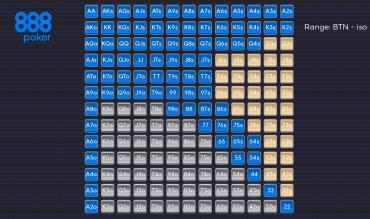
The BTN is typically one of the best places to iso-raise from at the table so our range can be somewhat wide. There are only two opponents to act behind us, and we are guaranteed to have position if called.
The standard for an in-position iso-raise is generally considered to be 4bb.
Iso-Raising from the CO
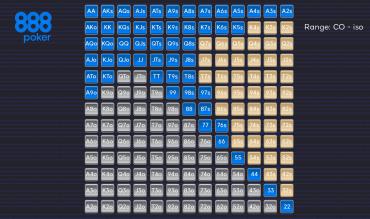
We should be able to see immediately that the recommended iso-raising range from the CO is significantly tighter than on the BTN. Although we will be in-position if the limper calls us, we have three opponents left to act behind us, one of which has position on us (BTN).
Worthy of note is that iso-raising ranges are typically weighted towards raw equity. Therefore, we tend towards iso-raising holdings such as K6s rather than 65s.
Iso-Raising from MP
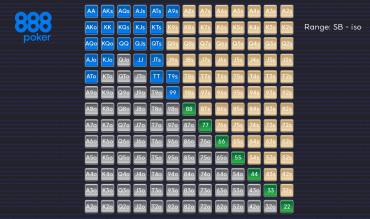
With 4 players still to act behind us, we should be somewhat reserved in this position. We always like to isolate ourselves against weaker players wherever possible, but there is a limit to how wide we can go.
The reason for this is not so much to do with the limp caller’s range, but instead because there are so many players behind us who might cold-call or squeeze.
Iso-Raising from SB
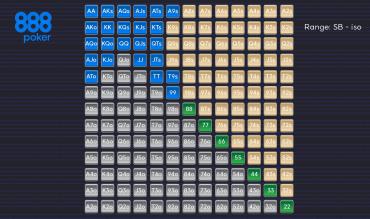
We might imagine that SB should be iso-raising wider than the BTN, but there is one fundamental problem. The SB is guaranteed to be out-of-position postflop, which is a significant disadvantage.
Our iso-raising range needs to reflect this by being on the tighter side. Standard sizing for iso-raising out-of-position is generally considered to be 5bb.
Besides, it’s worth keeping in mind that just because we don’t iso-raise a hand doesn’t mean that it has to be folded. We should actually look to play as many as 70% of holdings from the SB when facing an open-limp.
Many players have been trained never to complete in the SB, but strong players realise that it is a valid option and can boost winrate when used correctly. We might think about completing the following range in the SB when facing an open-limp.

Iso-Raising from the Big Blind
Correct iso-raising ranges from the big blind will vary depending on whether the limper is in the small blind or another position. If the limper is in the small blind, a big blind iso-raiser will be guaranteed postflop position.
Any other position and the big blind will be out-of-position when called. As such, it makes sense to have two different iso-raise strategies, one for in-position and one for out-of-position.
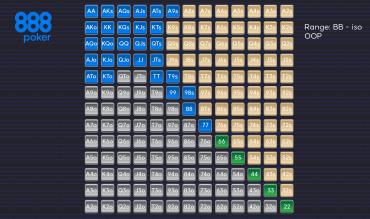
Firstly, let’s look at the big blind iso-raising range. Note that it is on the tight side, similar to the small blind iso-raising range. There is no need to iso-raise aggressively from this position for two reasons.
1. We will be out-of-position postflop.
2. Even if we don’t iso-raise, we’ll still get to see the flop anyway after checking.
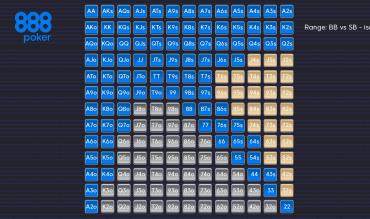
BB vs SB is a very powerful situation to iso-raise from. We are guaranteed position postflop, and no player behind us can cold-call or 3bet.
Adjustments to Default Ranges
The above ranges are merely a guide. Depending on the specific open-limper we might choose to adjust the above ranges.
Here are some examples -
Our opponent folds too frequently to isolation raises, so we expand our iso-raising range.
- Our opponent has a history of limp/raising so we tighten our iso-raising range.
- Our opponent has a shallow stack, so we avoid iso-raising some of the more speculative holdings.
- Our opponent folds extremely often to continuation bets, so we expand our iso-raising range.
It’s also worth noting that the above iso-raises are very much linked to the format in question, which is 6-Handed No Limit Hold’em cash games with 100bb effective stacks.
Different formats will require different iso-raising ranges, although many of the general principles will be the same.
Adjusting to Multiple Limpers
Sometimes, our opponent will open-limp, and another player will limp behind.
How should we respond when facing two (or perhaps more) limpers?
Large adjustments do not need to be made to the iso-raising ranges for this eventuality. Although it does make sense to increase the iso-raise sizing somewhat.
Formula for in-position: 4bb + 1bb for every additional limper.
Formula for out-of-position: 5bb + 1bb for every additional limper.
Hence our default sizing in-position when facing 2 limpers would be 5bb and our default sizing out-of-position when facing 2 limpers would be 6bb.
It makes sense to slightly tighten each of the ranges when facing multiple limpers, but nothing dramatic is required.
Quick Notes on Continuation Betting
Studies on average flop folding frequencies after limp/calling preflop show that the average limp/caller is folding significantly too often when facing a continuation bet. Therefore, as the iso-raiser, it will usually make sense to c-bet somewhat aggressively.
Our default play should merely be to fire a continuation bet unless we have a decent reason for not doing so. Even garbage hands can easily make sense as continuation bets, especially when we are in-position.
Data suggests that the average limp/caller folds around 50% of the time when facing continuation bets out-of-position.
Adjustments to Default Sizings
Since iso-raises are typically made against weak opposition, we don’t need to be concerned regarding using balanced sizing. For example, if we feel that we can get away with raising premium value hands for larger sizings, we should go ahead and do this.
Certain especially volatile types of opponent have been known to call iso-raises of 20bb and larger. If a player is routinely willing to call such sizes after limping, then it makes little sense to iso-raise our AA to a mere 5bb.
On the flip side of the coin, iso-raises made with speculative holdings (especially against opponents with shorter stacks) usually work best with sizings slightly smaller than the default recommendations.
We should be able to think outside the box and be flexible rather than doggedly sticking to the same default iso-raise sizings.


